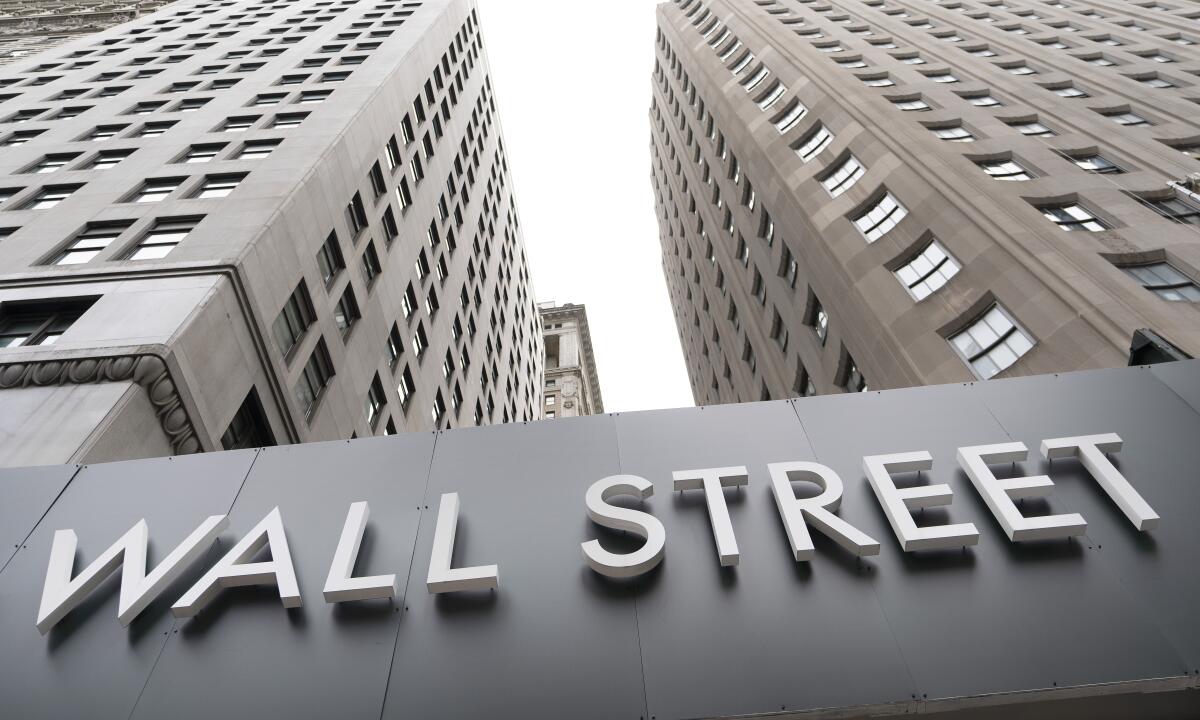Stocks end another bumpy day lower; crude oil prices ease

- Share via
Stocks fell and oil prices eased back Thursday after another bumpy day of trading on Wall Street as markets remained anxious about the broader effects of Russia’s invasion of Ukraine.
Major indexes seesawed for much of the day before a late-day slide pushed them into the red. The Standard & Poor’s 500 index gave up a 0.7% gain and closed 0.5% lower, while the Dow Jones industrial average fell 0.3%. The Nasdaq composite fell 1.6%, weighed down by technology stocks, which accounted for a big share of the market’s decline. The pullback left the indexes on pace for weekly losses.
Bond yields were mostly steady. The yield on the 10-year Treasury slipped to 1.85% from 1.86% late Wednesday.
Stocks rallied a day earlier after Federal Reserve Chair Jerome H. Powell said he favored a modest interest rate increase at the Fed’s policy meeting in two weeks, bringing relief to investors who had feared he would back more aggressive moves to fight inflation.
The Fed is expected to raise its benchmark interest rate soon in an effort to slow inflation. Here’s what it can do and what effects that might have.
“We’ve gotten a lot of clarity on what the Fed plans to do,” said Liz Young, chief investment strategist at SoFi. “But we’ve got this overhanging cloud of the geopolitical risk and oil prices still pressuring sentiment a little bit.”
The S&P 500 fell 23.05 points to 4,363.49. The Dow slid 96.69 points to 33,794.66. The Nasdaq dropped 214.07 points to 13,537.94.
Smaller-company stocks also lost ground. The Russell 2000 index fell 26.46 points, or 1.3%, to 2,032.41.
Communication companies, retailers and others that rely on direct consumer spending had some of the broadest losses. Sectors that are viewed as less risky, including utilities and household goods makers, gained ground.
The broader market remains volatile as investors continue to worry about the conflict in Europe along with higher inflation and the effect on economic growth and how central banks around the world act to try to restrain inflation.
A sanctions regime aimed at putting pressure on Russia’s wealthiest citizens has put a spotlight on the global mega-yacht trade.
The economic fallout from the Russian invasion expanded as Fitch Ratings, Moody’s Investors Service and S&P Global Ratings cut Russia’s credit rating. It was S&P’s second Russia downgrade in less than a week. The ratings giants said the invasion and Western sanctions have hurt Moscow’s ability to repay debts and raised risks for the economy and stability.
The London Stock Exchange said it had suspended trading in shares of 27 companies with links to Russia, including some of the biggest in energy and steel, such as Lukoil, Gazprom, Sberbank, Rosneft and Magnitogorsk Iron & Steel Works. Those shares lost most of their value before the suspension. Rosneft shares dropped from $7.91 on Feb. 16 to 60 cents on March 2, while Sberbank shares plunged from $14.90 to 5 cents in that same time frame.
Trading on the Moscow exchange remained closed Thursday. Russia’s ruble lost an additional 15% against the U.S. dollar and is worth less than 1 cent. It has plunged since Western governments imposed sanctions that cut off much of Russia’s access to the global financial system.
The exposure and overlap that U.S. markets have to Russia is relatively low. The real risk is the exposure that European banks have to Russia, Young said.
“If European banks start to feel the contagion of that, then it’s about what’s our exposure to Europe, which surprisingly is still reasonably low,” she said. “That doesn’t mean there’s not sentiment risk. Nobody likes to hear about financial markets freezing up.”
Russia’s invasion of Ukraine has been the dominant issue for investors all week as they try to assess its global economic impact. Russia is a key oil producer and prices have been rising as global supplies remain threatened by the conflict, raising concerns that persistent inflation could become even hotter.
Leaders of OPEC and other major oil-producing countries are sticking with plans to gradually increase oil production. Meanwhile, the U.S. and other major governments in the International Energy Agency plan to release 60 million barrels from strategic reserves to boost supplies.
The price of U.S. benchmark crude oil fell 2.6% to $107.67 a barrel and Brent crude, the international standard, fell 2.2% to $110.46. Both are up more than 17% for the week.
Rapidly rising prices and the Fed’s reaction are still a big focus for investors with the effect of the conflict uncertain. Powell gave a second day of testimony before Congress on Thursday, telling the Senate Banking Committee that Russia’s invasion of Ukraine probably will further magnify the high inflation that has engulfed the U.S. economy.
At the same time, Powell said he is committed to doing whatever it takes to slow inflation, underscoring the central bank’s high-risk challenge in raising interest rates enough to stem inflation without tipping the economy into another recession.
Investors will get another update on the U.S. job market Friday when the Labor Department releases its report for February.
“What we’re poised for is to really look hard at the jobs report tomorrow to see what the Fed needs to do and the state of the economy,” said Rob Haworth, senior investment strategist at U.S. Bank Wealth Management. “Tomorrow’s average hourly earnings will provide a good read on inflation and whether consumers are able to keep up.”
More to Read
Inside the business of entertainment
The Wide Shot brings you news, analysis and insights on everything from streaming wars to production — and what it all means for the future.
You may occasionally receive promotional content from the Los Angeles Times.












